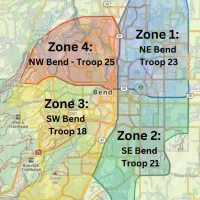Bend Ore. – Oregon Parks and Recreation Department Director Lisa Sumption has decided not to pursue rule amendments on the Upper Deschutes State Scenic Waterway.
Sumption made her decision after studying a report summarizing input from an advisory group that reviewed current regulations and comments collected through public meetings and web surveys. The report and other documents related to the review are online at http://bit.ly/upperdeschutesreview .
Aided by a local nonprofit facilitator, Community Solutions of Central Oregon, department staff convened an advisory group and gathered input from the general public to complete a limited review of all rules affecting the 1-mile section of the Scenic Waterway within Bend’s southern urban growth boundary.
The review focused on the perceived effectiveness of current rules intended to protect fish, wildlife, cultural resources, recreation, and other river values. Scenic Waterway rules cover not just bridges and crossings, but vegetation management, the visibility of structures and recreation facilities, the placement of commercial services, as well as other protections intended to preserve river values.
Community Solutions of Central Oregon summarized comments from the advisory group, three open house public meetings, and more than 300 online comments to produce the May 5, 2017 report. It emphasized several main issues:
+ Demand for recreational opportunities is increasing, putting pressure on natural resources and raising concerns among property owners adjacent to major recreation corridors.
– Fish, wildlife, recreation, scenic, and other waterway values may receive variable levels of protection by current scenic waterway rules.
– Continued development pressure means more coordination and cooperation are needed between public agencies, residents, and recreation enthusiasts.
– The balance between recreation, resource protection, and property rights is strained.
Based on the report, Director Sumption concluded that, while increased coordination with public, private, and other governmental organizations could improve rule effectiveness, she found no reason to pursue a rule amendment specific to the Upper Deschutes.
“I would reconsider amending rules in the future if that would clearly strengthen protection of the waterway,” Sumption said. “As important as recreation is to our mission, it has to be balanced with our need to protect resources that make recreation possible. Changing rules, especially in a way that might encourage more visible riverside development, is contrary to the purpose of the scenic waterway system.”
Instead, Sumption directed department staff to work with other statewide agencies on ideas to strengthen criteria and standards for protecting resources, especially fish and wildlife, on current and future waterways as part of a broader effort to fulfill the intent of the original 1970 State Scenic Waterway law.
“There is no clear way to gauge how successfully the State Scenic Waterway Program protects our most scenic rivers and lakes,” said Director Sumption, “While we’ve finished looking at this one small portion of the Upper Deschutes and plan no further action there, the review has highlighted an important statewide need for better management of the system.”
Landowners along State Scenic Waterways are asked to follow basic rules intended to preserve riparian habitat and mitigate the intrusion of new development on the public’s recreational experience of the river. Oregon Parks and Recreation Department staff review projects and work with landowners to help them develop and care for their property in ways that comply with State Scenic Waterway rules.
In rare cases where a compromise can’t be found and the property owner receives a denial from the department, the law allows the property owner to set aside the scenic waterway rule after a 1-year waiting period.
More information about the state scenic waterway system is online at http://www.oregon.gov/oprd/NATRES/scenicwaterways/Pages/index.aspx















